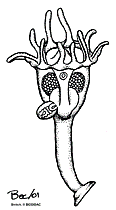Summary
Ecology
Life History & Behaviour
Fossil Record
Behaviour
Reproduction and Development
Anatomy & Physiology
Body
Transport, Excretion, Nervous System
Evolution & Systematics
Phylogeny
Diversification and Classification
Biogeographic Distribution
Conservation & Threats
References & Links | Reproduction and Development
Most of the entoprocta species are hermaphrodites and either colonial or solitary can have sexual or asexual reproduction (clones by budding). The changes of sex can occur in some species due to environments circumstances. The gonads can be in number of one or two placed between the atrium and stomach. Most of the species have eggs that hatch into planktonic larvae, but in other cases, larvae complete early development in a brood chamber (located in the atrium). The development of the embryo is a holoblastic pattern typical, of protostomes organisms, producing a Trochophore* larvae. After around 7 months the larvae settles in a favorable site.
Trochophore larvae (as figure below) have a lot of cilia to feed, sensory bunches of cilia, light-sensing organs, a complete digestive system, and a pair of protonephridia for waste excretion. Most of the larvae will undergo a metamorphosis in which a lot of different changes occur and even the rotation In 180° of the gut is possible to happen.

Experimental evidence shows that temperature can influence on the sexual maturity, favoring warmer waters to mating season occurrence.
Colonial species, as the one from Heron Island, usually produces new individual by cloning from the stolon or stalk, increasing the colony size.
*Trochophore:Type of free-swimming planktonic marine larva with several bands of cilia.

|
|